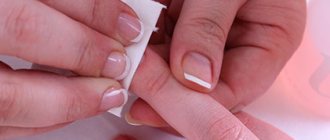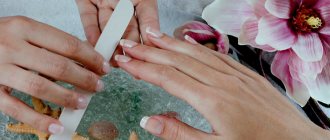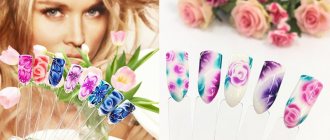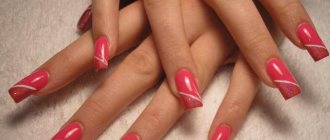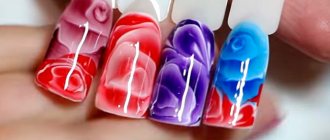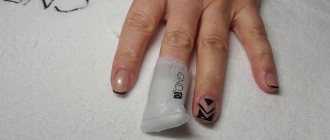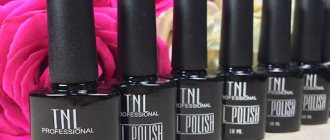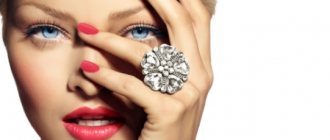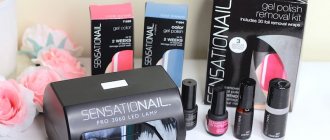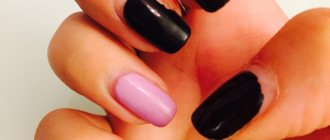Required Tools
Almost every woman has the tools already listed earlier in the table, or some of them. Each of them has its own purpose, application and processing features.
What do you need:
- An orange stick, like a metal pusher, is designed to lift the cuticle and open the subcuticle pocket. It is made of wood and is disposable. It is considered safer for the nail when cleaning pterygium from the surface of the nail plate under the cuticle.
- The pusher is similar in functionality to an orange stick. A special feature of the tool is the ability to choose the shape and size of its spatula. Most often, there is a sharp, flat device on the opposite end of the pusher to clean out the sinuses.
- It is preferable to choose cuticle scissors with long thin blades, slightly rounded (anatomical) in shape. Depending on individual preferences, they can be replaced with tweezers. The sharpening of these tools should be as sharp as possible, so it is better to have a second copy for cutting nails and rough skin.
- Natural nails must be filed using soft abrasive files. Manufacturers of this product offer disposable full-fledged files on a soft base or replaceable files on an adhesive base. The files are attached with the sticky side to a special metal spatula.
Square long nails
Square long nails are not uncommon. This is a fairly popular form that will require proper design of the free edge. Here you should choose a soft square, since too sharp corner parts will cause long nails to quickly break. Sometimes the square shape is replaced with a rounded square shape, which will immediately affect the overall appearance of the manicure.
For a more successful selection, you should contact a specialist at the salon, who will take into account all the pros and cons and recommend the best choice.
Precautionary measures
- Regardless of where you perform the procedure, at home or in the salon, use an antiseptic before starting work. A combined manicure involves working with clippers, which means it is necessary to minimize the risk of infection. How and with what to disinfect, sterilize and clean manicure instruments
- Perform manicures only on healthy nails. The work of a cutter, pusher and nippers is relatively safe, but still affects the nail. When a gash forms or a wound appears, it is unknown how the disease will react;
- Do not use tools after they are dull and do not neglect their treatment. The only exception for sterilization will be paper-based files, which, in fact, are a disposable instrument. Cutters, nippers and pushers must be processed, even if used for home combined manicure.
Round long nails
The round shape achieves a visual circle of the regrown edge and the overall nail plate by rounding it. This is a rather insidious form, which in other cases lengthens the fingers, and in others inevitably thickens them. This form is good for chubby and short fingers, but provided that the nail bed itself is wide enough. The round shape requires a lot of length to get a beautiful circle, but at the same time infrequent correction. Everything here will depend on the growth rate of your nails.
Alternatives to the classic edged manicure
In recent years, the so-called European manicure, which is based on the principle of untrimmed cuticle removal, has gained popularity. The European unedged manicure uses a special remover, which is applied to the area around the nails and literally in a minute softens the skin and allows you to remove dry areas of the cuticle and pterygium with an orange stick. Cutting tools in this manicure are used only to remove burrs, and therefore unedged manicure is recognized as the most gentle and safe.
Common mistakes
- When cleaning the pterygium under the cuticle, it is strictly forbidden to tear the cheek of the cutter from the nail. The slightest change in the angle can cause a groove in the plate to be cut, which will heal in about 6 months.
- Be careful when checking the pocket under the cuticle for remains of the pterygium. The resulting gash, which you might not have noticed, as well as the skin growth, will have a whitish tint. When you try to file down what appears to be a growth, you risk filing down the nail even more and deforming the nail plate.
- If at the grinding stage a large uncut piece of cuticle is discovered, it is better to remove it with scissors or nippers. Grinding with a milling cutter will be long and not very pleasant.
Hardware manicure - answering frequently asked questions
Combined manicure, the procedure is not as complicated as it might seem - the most important thing is to find your tools and a comfortable position for your hand. The result of the treatment will be a clean, shiny nail, neat cuticle and velvety skin on the side ridges. Which manicure do you prefer?
French manicure classic
A classic French manicure (French) is performed using different technologies: the smile line is drawn freehand with a brush, special stencils are used, the tip of the nail is dipped in acrylic powder or glitter, and a special brush is used for a French manicure. Whatever method you choose, the technique for preparing the nail plate will be approximately the same. The exception is the stage of creating a base: you can use a base and then apply a light gel polish, or you can use special colored translucent bases for a jacket. To draw a smile line, different materials can also be used: thick gel polish or thicker gel paint.
Step-by-step instructions for making a classic French jacket
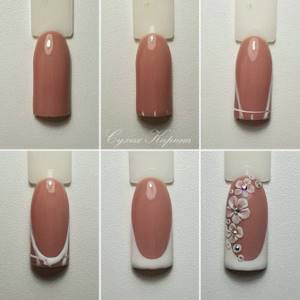
Reason No. 4: fashion for naturalness
It's paradoxical, but unusual nail designs have become commonplace. It’s already difficult to surprise anyone with bright colors, complex patterns and even voluminous rhinestones. Even if you paint all 10 nails in different colors, you won’t get a stunning effect, but it will always seem like you have a popular chocolate dragee on your hands. (Checked personally by the author of the article.)
Famous actresses, bloggers and opinion leaders are increasingly appearing in public with bare nails or clear nail polish. The fashion for naturalness is gaining momentum, including in the wake of the impending general environmental disaster.
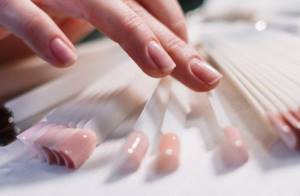
Long sharp nails
The sharp form is considered the most controversial, because sharpness makes long nails vulgar, flashy, inconvenient for everyday life and even dangerous, but at the same time it beautifully emphasizes women’s hands and looks perfect in photographs. Masters are advised to select a similar form for nail art exhibitions, when the master uses the client as an indicator of his skill. But in real life it is very difficult with sharp nails, and long ones at that.
They can easily cut you, pierce clothes, and make it simply impossible to quickly pick up ordinary objects. So before choosing such a form, you should think about its feasibility.
